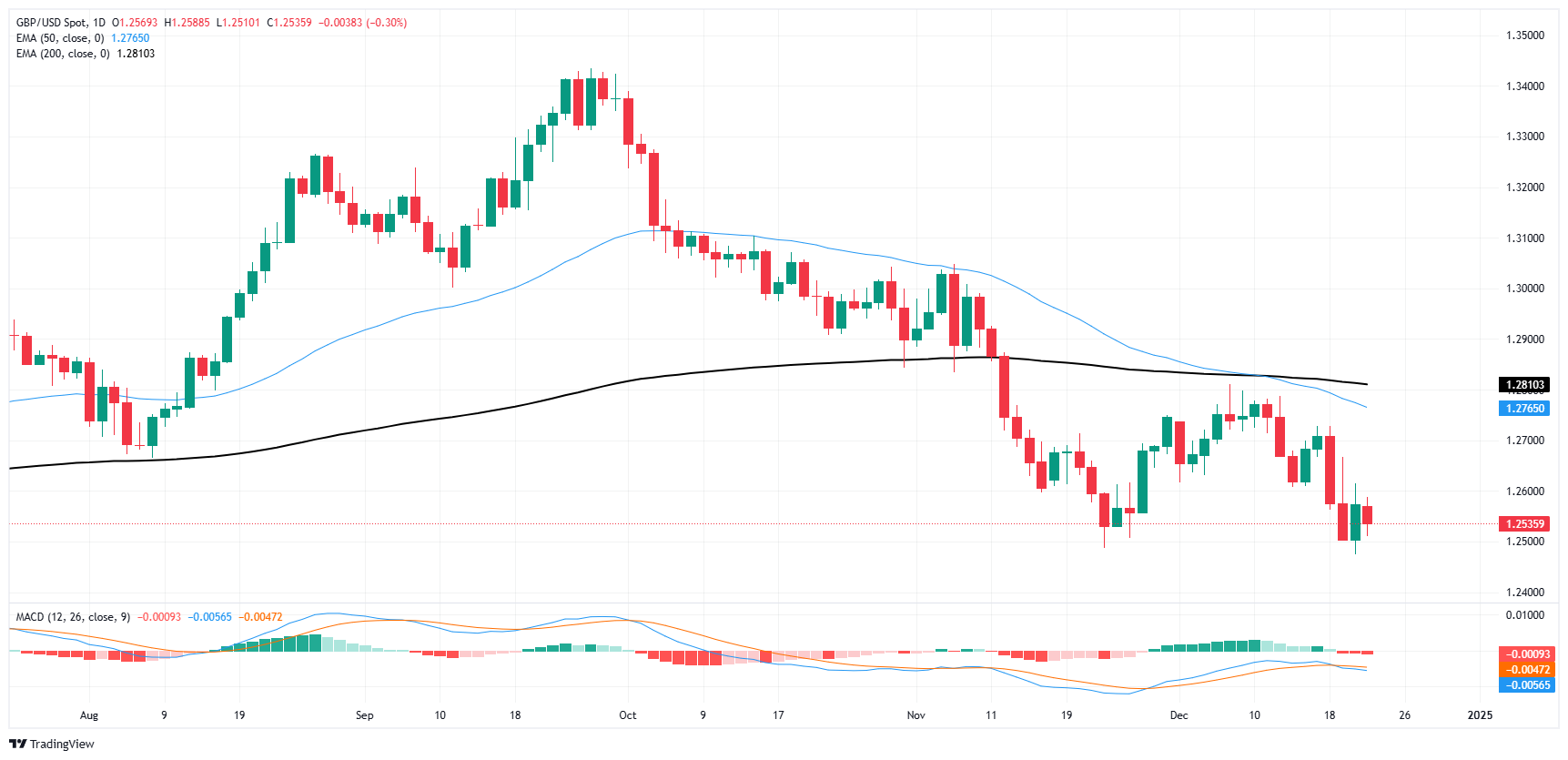GBP/USD set to swoon on holiday-shortened week
- GBP/USD held on the low side of 1.2550 on Monday.
- Money markets are constricting ahead of the midweek Christmas holiday.
- UK GDP figures slightly missed the mark to wrap up the GBP’s data docket early.
GBP/USD waffled near the 1.2550 level on Monday, kicking off the holiday trading week with a third of a percent decline as market sentiment coils. Market volumes are set to drain out of global exchanges as investors broadly hang up their hats for the Christmas holiday, and global markets will be shuttered on Wednesday.
UK Gross Domestic Product (GDP) missed to the downside early Monday, with quarterly UK GDP easing to a flat 0.0% in the third quarter compared to the expected hold near 0.1%. Annualized UK GDP also missed forecasts, coming in at 0.9% YoY. Investors had expected the yearly figure to print in-line with the previous period’s figure of 1.0%.
US Durable Goods Order also missed the mark on Monday, putting a capstone on a downturn in broad-market sentiment. US Durable Goods Orders fell in November, printing at -1.1% compared to the expected print of -0.4%, and entirely walking back the previous month’s revised 0.8% figure. Most of the losses in Durable Goods Orders were from automotive purchases, with core Durable Goods Orders (excluding automotive) printing at -0.1%, still down from the forecast 0.3% but a sight better than the headline figure.
Overall market reaction to data has been limited to start the week, and will only get worse as market liquidity dries up. Meaningful data is functionally done for the week on both sides of the Atlantic, though US Initial Jobless Claims for the week ended December 20 are due on Thursday. Whether or not there will even be traders at their desks to see the data cross the wires is another matter entirely.
GBP/USD price forecast
GBP/USD continues to trade on the wrong side of the 200-day Exponential Moving Average (EMA) near 1.2800, with price action lagging into the 1.2500 handle. A bullish turnaround fizzled in late November, and Cable prices are set to continue languishing.
The pair remains down nearly 7% from September’s peaks near 1.3400. Any fresh attempts at generating bullish momentum will need to get over the last swing high, with technical resistance clustered near the 50-day EMA near 1.2765.
GBP/USD daily chart
Pound Sterling FAQs
The Pound Sterling (GBP) is the oldest currency in the world (886 AD) and the official currency of the United Kingdom. It is the fourth most traded unit for foreign exchange (FX) in the world, accounting for 12% of all transactions, averaging $630 billion a day, according to 2022 data. Its key trading pairs are GBP/USD, also known as ‘Cable’, which accounts for 11% of FX, GBP/JPY, or the ‘Dragon’ as it is known by traders (3%), and EUR/GBP (2%). The Pound Sterling is issued by the Bank of England (BoE).
The single most important factor influencing the value of the Pound Sterling is monetary policy decided by the Bank of England. The BoE bases its decisions on whether it has achieved its primary goal of “price stability” – a steady inflation rate of around 2%. Its primary tool for achieving this is the adjustment of interest rates. When inflation is too high, the BoE will try to rein it in by raising interest rates, making it more expensive for people and businesses to access credit. This is generally positive for GBP, as higher interest rates make the UK a more attractive place for global investors to park their money. When inflation falls too low it is a sign economic growth is slowing. In this scenario, the BoE will consider lowering interest rates to cheapen credit so businesses will borrow more to invest in growth-generating projects.
Data releases gauge the health of the economy and can impact the value of the Pound Sterling. Indicators such as GDP, Manufacturing and Services PMIs, and employment can all influence the direction of the GBP. A strong economy is good for Sterling. Not only does it attract more foreign investment but it may encourage the BoE to put up interest rates, which will directly strengthen GBP. Otherwise, if economic data is weak, the Pound Sterling is likely to fall.
Another significant data release for the Pound Sterling is the Trade Balance. This indicator measures the difference between what a country earns from its exports and what it spends on imports over a given period. If a country produces highly sought-after exports, its currency will benefit purely from the extra demand created from foreign buyers seeking to purchase these goods. Therefore, a positive net Trade Balance strengthens a currency and vice versa for a negative balance.
